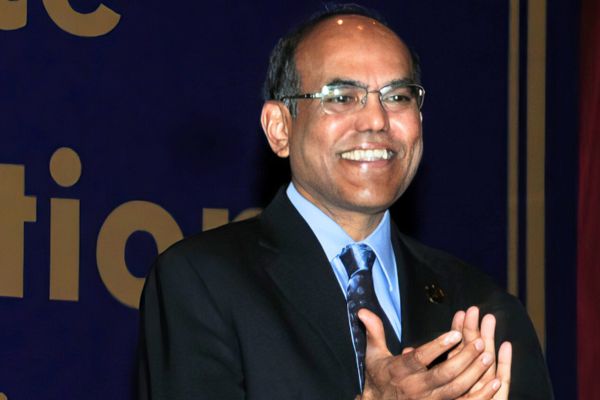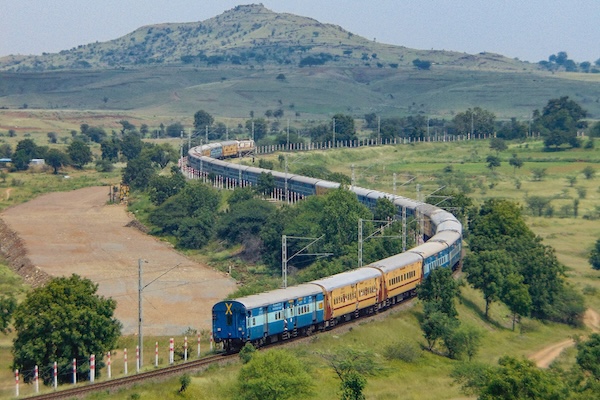.png)
India Is A Poor Rich Nation, Can’t Grow Without Fixing Inequality: Subbarao
Former RBI Governor Subbarao says rapid growth alone won’t deliver prosperity; India must share gains widely and fix structural imbalances.


Kalyan Ram, a financial journalist, co-founded Cogencis and now leads BasisPoint Insight.
June 3, 2025 at 3:29 AM IST
India may now be the world’s fourth-largest economy, but that is no reason to celebrate, says former Reserve Bank of India Governor Duvvuri Subbarao. In a measured and penetrating conversation, he warns that India’s economic rise masks deep vulnerabilities. Unless growth becomes more inclusive, job-rich, and structurally sound, the dream of a “Viksit Bharat” by 2047 may slip out of reach.
The country’s GDP, currently around $3.7 trillion, has edged past Japan and is on course to overtake Germany. But Subbarao flags India’s low per capita income to argue that size alone is misleading. “We’re a large economy because we have a large population. But we’re still a poor country,” he says. “Only when we reduce poverty meaningfully will there be a cause for celebration.”
Subbarao spoke to BasisPoint Insight on the theme: “India 2047: Raising the Game for a Developed Future” at his Hyderabad home. The interview is spread across a four-part series.
The government’s ambition to become a developed nation by 2047 hinges on sustaining 8% annual growth for over two decades. Subbarao doesn’t deny the arithmetic, but points out the difficulty of sustaining such momentum. Since liberalisation, India has achieved 8% growth multiple times, but never maintained it for more than two consecutive years.
And even that growth, he insists, must be of the right kind. “Mere expansion of GDP won’t suffice,” he says. “We need growth that reduces inequality and creates jobs.”
India adds about 10 million people to its labour force each year, and faces an existing backlog of at least 50 million job seekers. Rising agricultural productivity and improved female participation could further swell the non-farm labour pool.
To absorb this surge, Subbarao calls for urgent support to job-intensive sectors, particularly small and medium enterprises. He also points to India’s structural Achilles’ heel—the risk of falling into the middle-income trap. Many countries transition from low to middle income by adopting technology and shifting labour from farms to factories. But few manage the leap to high income, which requires innovation, strong institutions and governance, and a willingness to invest in human capital.
India has shown sparks of such potential. Its moon landing at a fraction of NASA’s cost and advances in digital infrastructure reflect frugal innovation. But Subbarao cautions against complacency. “We need much more of that mindset, backed by systems that reward talent, allow risk-taking and uphold the rule of law,” he says.
On the macro front, he defends the government’s fiscal restraint and warns against growing calls for expansionary borrowing. “You cannot fund consumption with debt and expect future generations to pick up the tab,” he says. “Public investment is welcome, but it cannot be the sole growth engine.”
Ultimately, Subbarao’s message is clear: India must earn its growth and share it. Otherwise, it risks being a large economy that remains a poor society.
Edited excerpts of the interview with Subbarao:
Q: India is now the world’s fourth-largest economy, having reportedly overtaken Japan. How significant is this milestone—and is it a moment to celebrate?
A: Well, as you mentioned, India is reported to have surpassed Japan. So we are now the fourth largest economy in the world, behind the US, China, and Germany. Expectations are that we will overtake Germany also in a couple of years from now.
What is even more important than being a large economy is that we are also a fast-growing economy. Since the pandemic, we've clocked rapid growth. Rapid growth is significant, of course, for us, but it is also significant for the world. I'll tell you why. There are economies which are growing more rapidly than India, like Vietnam and Ethiopia, but they are small. There are economies larger than India — like the US, China and Germany — but they are growing slowly. A large economy like India growing rapidly is a tantalising prospect for the world because it adds to global demand. Today, India accounts for about 16-17% of global demand.
You asked whether our leap from fifth to the fourth position is a cause for celebration. I would say it's a cause for cheer, not for celebration. We are a large economy mainly due to our large population. But the measure of how rich or poor a country is via per capita income. With a per capita income of just $2,700, we rank about 137 or 138 in the league of nations. So, we are still a poor country. The challenge for us is not only to grow rapidly but to ensure that the benefits of growth are widely shared. Only then will there be a cause for celebration.
Q: The Prime Minister’s Viksit Bharat vision implies India must sustain about 8% growth for the next quarter-century. Is that pace realistic, and what will it take to achieve it?
A: First, a bit of background on where that 8% figure comes from. We just spoke about our per capita income today being about $2,700. The IMF benchmark for a rich country is a per capita income of about $21,760, or let’s say $22,000. That means to become a rich country, our per capita income has to multiply eight times. If you take 22 years between today and 2047, and do simple arithmetic, you get the number: India has to clock growth of 8% annually for the next 22 years to reach rich country status by 2047.
The question is, can we do that? If you look at our growth trajectory over the last 35-plus years since economic reforms, we clocked growth of more than 8% seven times. But we’ve never been able to maintain that growth for more than two consecutive years. So, maintaining annual growth of 8% consistently for over two decades is a tall task. I must add though that it’s difficult but not impossible.
There are many things we have to do to grow at 8%. That’s a large and complex agenda. But I want to point out two important things.
First, mere growth will not do. We need growth that reduces inequality — growth where prosperity is widely shared. Inequalities are morally wrong and politically corrosive, but they are also bad economics. One of our big growth drivers is consumption. About 800 million people have less than a middle income. If their incomes grow, they will consume more, spend more, leading to more production, more jobs, and higher growth. We can get onto a virtuous cycle. Therefore, to keep our growth sustainable, we must ensure the benefits of growth are widely shared.
And that takes me to my second point. To reduce inequalities, we need to create jobs. There’s been a lot of talk about jobless growth. About 10 million people join the labour force every year, and we’re not even creating half as many jobs. There’s already a backlog of at least 50 million in the labour force. If agricultural productivity rises, as we want it to, at least another 50 million people will shift to the non-farm labour force. An improvement in the female labour force participation will add another 50 million to the pool. So, the challenge of job problem is enormous.
Becoming a rich country will require more than growth — it requires that the benefits of growth be widely shared. That means focusing on reducing inequalities and creating jobs.
Q: So, what should the strategy be to ensure employment increases and growth is more equitable? From a policymaker’s perspective, what should be the approach?
A: We’ve already touched on the two key priorities: reduce inequality and create jobs. But I’m not just referring to income inequality. I’m talking about inequality in a much broader sense — education inequality, health inequality. World Bank research shows that good-quality education is the surest path to upward mobility across generations. So, we must focus on educational achievement, the quality of education. Similarly, health. Poor health limits one’s ability to work and earn. So, we need to focus on improving health standards.
On jobs — there’s no magic formula. But I believe we need to focus on job-intensive sectors, especially the SME sector, which feeds into the corporate sector and is employment-intensive.
Q: Niti Aayog has mentioned that one of the threats to India becoming a developed nation is the so-called middle-income trap. How best can we avoid this?
A: First, a little background. Development experience over the last 75 years shows that countries find it relatively easy to transition from low income to middle income. But they find it exceedingly difficult to move from middle income to high income. That’s what we call the middle-income trap.
Why does the middle income trap manifest? As countries grow, they typically shift from agriculture to industry and then to services. Moving from agriculture to industry is relatively easy — you’re leapfrogging over generations of technology and catching up with the latest. That transition unleashes productivity, moves labour into higher-value sectors, and enables middle-income status.
But moving from middle income to high income requires innovation — being on the technological frontier. That’s much harder. Low to middle is about catching up with the latest technology. Middle to high is about pushing the technology frontier. That needs investments in higher education and a culture of innovation.
Take a simple example. DeepSeek, for instance, came from China, which has invested in innovation. India too — we landed on the moon last year at a fraction of NASA’s cost. That’s a testament to our innovative capacity. We need much more of that to avoid the middle-income trap.
Q: Coming to recent episodes of growth, we’ve done a fairly good job emerging from the pandemic-induced slowdown. The Indian economy grew rapidly. But subsequently, we do see considerable headwinds. Do you think these are cyclical headwinds, or do they point to something more structural that needs to be addressed to achieve 8% growth?
A: As you said, after the pandemic, we clocked rapid growth. But in 2024-25, growth came down to around 6.5% or possibly even lower. This year too, growth is expected to be around that number. So, there is concern that we’ve slowed from 8%-7.5% to 6%.
There’s a lot of debate — like you asked — on whether this slowdown is structural or cyclical. Opinion on this issue is divided.
Those who argue that it is cyclical point to several headwinds. There are global headwinds — geopolitical tensions, trade wars — and domestic headwinds like tight monetary policy by the RBI over the last two years to control inflation. They contend that these headwinds will abate.
Over the last several years, the government has invested heavily in public investment which will crowd in private investment in the years ahead. Also, in the last Budget, the Finance Minister provided income tax concessions, which will boost consumption among the lower- and middle-income classes. This boost in private investment and consumption will return us to a high growth trajectory. That’s the cyclical argument.
Those who say the growth slowdown is structural argue that growth was slowing even before the pandemic. The catch-up growth was exhausted. The post pandemic rapid growth was merely a rebound. But now all growth drivers seem weak. Over the last three or four years, growth has been driven almost entirely by government expenditure. But there are limits to how much the government can spend.
Consumption is not rising. For an economy growing at 7%, consumption is growing at barely 3-3.5%. That says something about inequality.
Private investment is not picking up. As a proportion of GDP, private investment has fallen from 20% to 13% in 2024. Export prospects are bleak because of global headwinds, which will not abate quickly.
So where are the growth drivers? No consumption, no private investment, no exports, and limited room for government expenditure. That’s the structuralist argument.
My own view is that the slowdown is partly structural and partly cyclical. We have to tackle both fronts.
Q: So what can be done to improve growth from a structural perspective? How can we ensure sustained structural growth?
A: I wish I could say something original here, but the answer is well known: structural reforms.
We need to ease regulation. We need land reforms, labour reforms, and taxation reforms — these are all important. But equally important are governance reforms.
We see the Prime Minister and Chief Ministers going around the world, inviting foreign investment. They go to Tokyo, London, New York — even Mumbai and Lucknow — and make promises. But are they walking the talk when back in Bhopal or Hyderabad or Amaravati? That’s the test.
Governance reforms — delivering on your promises — are critical. To structurally move to a higher growth trajectory, we need both structural reforms and governance reforms. I hope the Deregulation Commission that the government has announced will work seriously on these issues.
Q: One criticism — mostly from academics — is that the government expects the RBI to do most of the heavy lifting to support growth, while fiscal policy has been more orthodox. The government is focused on capital expenditure, assuming that is sufficient. Do you think that’s enough?
A: On the contrary, I don’t believe our fiscal policy is overly purist. The fiscal consolidation that the central government has undertaken is very much warranted. In fact, it’s critical that state governments too become fiscally more responsible.
We’ve had year-on-year fiscal deficits for decades. Fiscal deficits crowd out private investment because they pre-empt scarce resources. That pushes interest rates up.
Fiscal deficits also add to public debt, and larger debt leads to higher interest payments. Interest payments are now the largest item of expenditure for both the central and state governments. They are also the fastest-growing component. That means they pre-empt other desirable spending.
Fiscal deficits also fuel inflation by raising aggregate demand. They can trigger balance of payments crises — as we saw in 1991, and again in 2013 during the taper tantrums. For all these reasons, I think fiscal restraint is necessary.
Those who argue for more spending are not looking at the international evidence. Today, our public expenditure is about 28% of GDP. That is significantly higher than what China, Korea, or Japan had during their high-growth years.
So, the idea that government can drive growth simply by spending more is misguided. Government spending can support growth when there is demand recession, like in a Keynesian scenario. But the belief that government alone can indefinitely sustain high growth through spending is flawed.
Q: The reason I asked is because capital expenditure seems capped, and the private sector hasn’t really stepped up. Given weak consumption, one expectation was that the government would increase revenue expenditure — spend more on health, for instance — to boost consumption. Without that, can consumption increase on its own?
A: I believe it can. The way to raise consumption is to raise incomes. And raising incomes is not about making transfer payments — it’s about providing income-earning opportunities.
The government should focus not just on the quantum of growth but on the quality of growth – where should they spend to get the highest long-term return.
For instance, the focus on public investment in infrastructure over the last four years is welcome. Infrastructure quality has improved. The expectation was that this would crowd in private investment. That hasn’t happened yet, possibly due to underutilised capacity. Let’s hope that will materialise soon enough.
To reach a high growth rate and sustain it, the government should continue to focus on long-term growth drivers — like quality of education and health — rather than just income transfers.
Q: Some say India’s debt-to-GDP ratio, about 80%, is still manageable, especially compared with the US or UK. So why not borrow more?
A: I’ve heard that argument before, and I disagree. People say our debt-to-GDP ratio is within safe limits, so the government should borrow more.
But here’s the issue. Our governments — both central and state — are running revenue deficits. This means that we are borrowing at the margin to fund current consumption.
Borrowing for current consumption is simply unsustainable. We all understand this at a household level. Borrowing must finance something that generates returns — a debt must repay itself.
If you borrow for consumption, there’s no return, and the repayment burden falls on future generations. There’s an ethical angle here. Are we okay with consuming today and passing on the burden to our children?
Second, international comparisons with countries like the US and Japan are misleading. When talking about debt sustainability, you also have to look at the revenue-to-GDP ratio. Our revenue to GDP ratio of less than 20% is much lower than that of advanced economies. That means we can slip into a debt trap even at lower debt-GDP ratio than advanced countries.
Also, people say our debt is in local currency - rupees, so the government can always print money and repay. That is a recipe for disaster. You cannot inflate away your debt. Many countries have come to grief for trying to do so.
Even if our debt is in rupees, as an economy we rely on foreign capital. As long as we run a current account deficit, we need foreign savings. Those won’t come if our public finances aren’t credible. Macro stability is essential.
In short, to believe that there is headroom for more borrowing by the centre and states is misinformed.
Continued in Part 2, which deals with the review of the inflation targeting framework. Part 3 of the interview deals with the external sector, and Part 4 with fiscal federalism.



